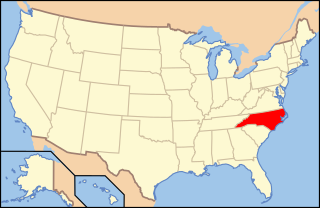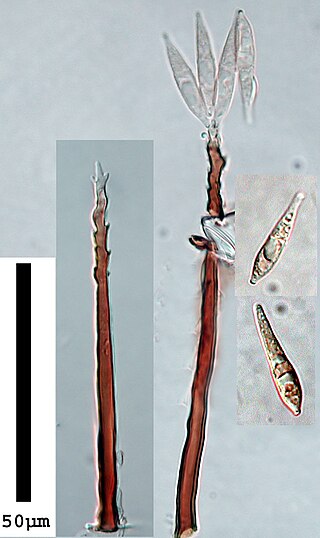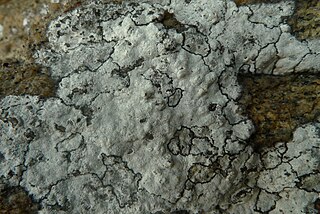Aquamarina is a fungal genus in the class Dothideomycetes. It is a monotypic genus, containing the single marine species Aquamarina speciosa, originally found in North Carolina, and distributed in the Atlantic Coast of the United States. The bluish-green species fruits exclusively in the lower parts of dying culms of the saltmarsh plant Juncus roemerianus.
Jobellisia is a genus of fungi within the monotypic family Jobellisiaceae and the monotypic order Jobellisiales and also the subclass Hypocreomycetidae, and class Sordariomycetes. The genus was circumscribed by Margaret Elizabeth Barr-Bigelow in 1993 with Jobellisia luteola as the type species. It contains species that grow on dead wood and bark in tropical and temperate regions of the Northern Hemisphere.

Candelariaceae is a family of lichen-forming fungi in the order Candelariales. It contains seven genera and about 73 species.

Paraphaeosphaeria pilleata is a species of fungus in the Lophiostomataceae family. The species fruits exclusively in the lower parts of the culms of the black needlerush. It is found on the Atlantic Coast of North Carolina.

The Pyriculariaceae are a family of ascomycete fungi in the order Magnaporthales. It was introduced by S. Klaubauf, M.H. Lebrun & P.W. Crous in 2014.

Lecanographaceae is a family of mostly lichens in the order Arthoniales. The family was circumscribed in 2014, prompted by a molecular phylogenetic-based restructuring of the Arthoniales.

Roccellographaceae is a family of lichen-forming fungi in the order Arthoniales. It contains three genera: Dimidiographa, Fulvophyton, and Roccellographa.

Carbonicola is a small genus of lichen-forming fungi. It is the sole genus in the monogeneric family Carbonicolaceae. The genus, which collectively has an almost cosmopolitan distribution, contains three squamulose lichens that prefer to grow on burned wood in temperate areas of the world.

Massalongiaceae is a small family of lichen-forming fungi in the order Peltigerales. It has three genera and seven species.
Cameronia is a genus of crustose lichens in the monotypic family Cameroniaceae. It has two species. Both the genus and its two species were described as new to science in 2011 by Australian lichenologist Gintaras Kantvilas. Characteristics of the genus include its chlorococcalean photobiont partner, and perithecioid ascomata that are deeply immersed in the substrate. Microscopic features of Cameronia include the four-spored asci with an intensely hemiamyloid outer wall and non-amyloid, well-developed tholus, and hyaline, muriform ascospores. Both species are endemic to the Tasmanian Highlands.
Austrotrema is a genus of lichen-forming fungi in the family Graphidaceae. It is primarily found in the Australian-Southeast Asian region. The genus is characterized by small, pore-like apothecia with a double margin, faintly amyloid ascospores, and stictic acid chemistry. Austrotrema species grow on tree bark and have a continuous thallus with a cortex that is prosoplectenchymatous–featuring densely packed, filamentous fungal hyphae that run parallel to the surface of the lichen, creating a compact and firm texture. The genus is closely related to Thelotrema and Leucodecton, but can be distinguished from them based on molecular phylogenetic data, specific morphological traits, and its secondary chemistry. Currently, Austrotrema comprises three species.
Savoryella is a genus of freshwater and marine based fungi in the family Savoryellaceae and the order Savoryellales.
Savoryella lignicola is a species of marine and freshwater based fungi in the Savoryellaceae family of the order Savoryellales. They are saprobic on submerged wood.
Pisorisporiales is an order of fungi within the phylum of Ascomycota and in the class Sordariomycetes and subdivision of Pezizomycotina and also its own subclass Pisorisporiomycetidae.
Pisorisporium is a genus of freshwater and terrestrial fungi in the family Pisorisporiaceae and Order of Pisorisporiales and in the subclass of Pisorisporiomycetidae.
Dimidiographa is a genus of lichen-forming fungi in the family Roccellographaceae. It has three species of crustose lichens, with Dimidiographa loandensis serving as the type species.

Fulvophyton is a genus of lichen-forming fungi in the family Roccellographaceae. It has 11 species. Fulvophyton is characterised by its crust-like thallus, which is often pale yellowish-brown in colour. This genus features a photobiont from the green algal genus Trentepohlia and exhibits a unique arrangement of reproductive structures.
Protothelenella is a genus of fungi in the family Protothelenellaceae. It contains 11 species, some of which form lichens. Protothelenella species have a crustose thallus with spherical to pear-shaped, dark brown to blackish perithecia. Microscopic characteristics of the genus include bitunicate asci with an amyloid tholus, and ascospores that are colourless and contain multiple internal partitions. Some species grow on acidic substrates including rocks, soil, bryophytes, plant detritus or rotten wood. Other species are lichenicolous (lichen-dwelling), growing on species of Solorina, Peltigera, Pseudocyphellaria, or Cladonia.
Aspiciliopsis is a genus of lichen-forming fungi in the family Trapeliaceae. It has two species, both of which occur in the Southern Hemisphere.
Alloarthopyrenia is a monotypic fungal genus in the family Trypetheliaceae. It contains the single species Alloarthopyrenia italica, a little-known fungus that lives as a saprotroph on living tree branches. The fungus is known from material collected in Italy, for which it is named.







